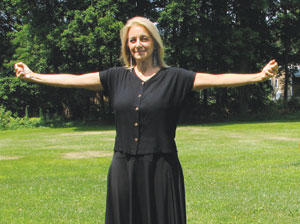Over the span of my career I have developed an unceasing desire to observe what I do, how I do it, and how I move doing it. This dates back to time spent as a serious ballet student from ages 7 to 14, followed by an interest in swimming, hiking, yoga, and folk dancing, all leading up to the big moment when I undertook the Alexander Technique. I have always placed a premium on movement because my body screams for it.
I have developed a series of favorite stretches and clocked how often I used them during a two-to-three hour practice session. Depending on my awareness, (which prompted me to remember a useful saying of Alexander’s: “Trying to do interferes with doing,” I found that I wanted to stretch as often as every four to seven minutes.
So take these movements and see how they work for you. (Of course consult with your doctor if you are at all concerned about certain movements for your body.) You may want to adapt them or make up your own as well. The release, relief, and breaking up of practice tedium can provide physical satisfaction and increased mental clarity.
1-3 Breathing Exercises
These breathing stretches will help you to take time to focus. I call this Healthy Completion and Healthy Depletion.
1. Inhale solely through the nose to fullest capacity while feeling the back and rib cage expand. Exhale rapidly making a hissing sound through the teeth, thrusting the airstream forward by pressing inward with the abdomen. Empty completely and repeat once again.
2. Inhale again solely through the nose to fullest capacity while feeling the back and rib cage expand. Exhale rapidly, this time singing and putting the lips into vibration simultaneously, as brass players do a warmup brrrrrrr. Start at the top of your vocal range and descend vocally with a massive glissando. Empty completely and repeat the process with a generous inhalation through the nose.
3. Repeat again with the deep inhalation through the nose, and this time exhale rapidly saying AH-H-H-H-H – not meekly, but with poise and full vocal projection. Empty and repeat again.
4. Flute swings: Hold the flute below hip level as if you were going to play it. Instead swing the flute up high, arms extended, and back down again, feeling the natural weight of the arms swinging like a pendulum and the subsequent lightness of the flute. Do many times to loosen up.

.jpg)
5. Neck stretches: Place the palm of your hand flat against one side of your head. Let the weight of the hands pull the head to one side. Do the other hand and other side.

6-7. Side Stretches: One arm over the head and one at your side—stretch as far as you can to one side, then do the other side. Then with arms above the head, hold your wrist with one hand and bend to the side. Stretch up and to the side, deeply. Repeat on the other side.

8. Making a face: Squish your face as tightly as you can: tight, tight, and then release opening the face up as widely as possible, eyes wide open, saying ahh, similar to the Lion face in yoga.


9. Reach for the sky: Standing on tip toes, extend one arm up to the sky or ceiling, reaching for the light, as high as you can. Repeat on the other side.

10. Pelvic Rolls: Hands on hips, bending the knees, keeping the shoulders steady and level, stretch as much as you can by rotating the pelvis, from left to right, to the rear and to the front. This should feel very good. Repeat.

11. The Scissors: I got this stretch from a former student at Indiana University, Alain Barker, who learned to do it in his native Durban, South Africa. Let the arms swing like pendulums, feeling the natural weight of the arms falling and lifting. Continue to swing back and forth, back and forth. On the count of 3, swing one arm forward and one backwards, simultaneously until the arms meet at the bottom. It should appear as though you are a human scissors. Repeat, this time swinging in the opposite direction.



12. Leg Stretches: Extend your leg on a chair as shown below and bend sideways – toward the leg and away from the leg. This position is similar to a ballet dancer stretching at the bar.

13. Spinal Stretch: While seated, turn your torso toward the back of your chair and grab onto the sides of the chair to get a spinal twist. Then go in the opposite direction.

14-18. Upper-arm warm-ups: These stretches are for the hands ultimately, by doing a simple balletic port de bras, or arm positioning.
14. Forward: First lift and move the arms together 10 times forward.

15. Backward: Next, try 10 times backward without forcing the arms to go too much to the rear.

16. Stretch your arms to the sides with the palms down. Then rotate the hands in very small circles, clockwise and counter clockwise; repeat many times.

17. Stretch your arms to the sides again, but make a fist this time. Rotate both hands clockwise and counter clockwise. Repeat many times until you start to feel the burn in the upper arms.

18. Repeat with the hands open and bent at wrist and like a paddle. Again rotate the hands clockwise and counter clockwise.

19 – 30: Repeat stretches #7 to the end. Enjoy and feel the pleasure of each stretch. It doesn’t matter so much what stretch you choose, just that you do it.






